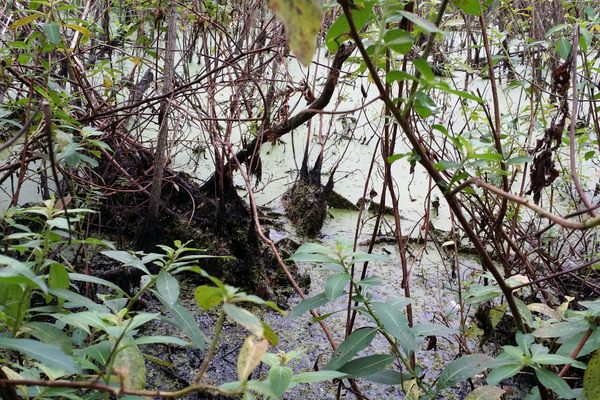

How Cherokee Trail of Tears Beans Connect a Community to Its Roots
“It’s not just preserving seeds, it’s preserving our culture, our history, our way of life.”

When I grow pole beans, it’s rare they even make it to the kitchen. I wander by the planting box, in the morning to get the mail or at night coming back from a bar, and pause to pull green beans off the vine. I crunch them between my teeth, the snap and the juice, a true pleasure of summer, second only to plucking ripe cherry tomatoes straight from the vine and into my mouth.
But when I grow Cherokee Trail of Tears beans, the vines are so prolific that I occasionally do fill up a colander of fresh beans to take inside. These may be blanched, shocked, and covered in butter, or blistered in a pan with hot oil and garlic. And even still, months later, as fall descends, I’ll pull back deadening leaves to reveal beans I missed, now dried. When I gather and shell them, the hard beans inside are shiny black or deep purple: a bean the color of mourning, but a plant of abundance and resilience.
Traditionally, the beans were eaten dried, cooked in soups or stews, and often with the corn and squash it was grown alongside. “One of our traditional foods is bean bread,” Feather Smith, ethnobiology manager with the Secretary of Natural Resources Office for the Cherokee Nation, tells me over the phone. “It’s sort of like making a corn masa and mixing the beans in with it and then steaming it.”


According to the Cherokee Trail of Tears Beans entry on the Ark of Taste, the beans were given to the nonprofit seed company Seed Savers Exchange in the 1970s by “Dr. John Wyche, a retired dentist and former circus owner who gardened atop a rock mountain in Hugo, Oklahoma.” The beans had traveled in the pockets of Cherokee who had been forced off their homelands in the Southeast by the American government in the 1830s, “removed” to Oklahoma. Seventeen-thousand Cherokee were the last of five tribes forcibly removed from the area. During the long winter trek to Oklahoma, 6,000 men, women, and children died. Wyche’s ancestors survived to put these black beans in the earth in the new Cherokee Nation. His family planted, harvested, and seed-saved these beans for 140 years before Wyche shared the seeds with Seed Savers.
What does it say about the significance of these beans that in a time of great distress, they were saved, carried, and replanted? Can our crops connect us from one homeland to our next?
“They didn’t have a chance to go back and grab everything, but if all they could grab was one thing, it was these seeds,” Smith says.

Even if both the knowledge-holders and the seeds made the journey, the new land was not always accepting of these crops. “Most of these are plants that thrive in eastern deciduous forest regions,” Smith tells me. “They don’t necessarily struggle here. They just grow very differently here. Our beans prefer a little bit of a cooler temperature. So it takes concessions to make them grow here. Some years are better than others, which is always true in gardening.”
In the early 2000s, the Cherokee Nation was invited to contribute native seeds to Norway’s Svalbard Global Seed Vault. While the Tribal government agreed that as a Sovereign Nation, their seeds should be represented, they discovered it was actually very difficult to find Cherokee heirloom crops within the Cherokee Nation of Oklahoma. “We had stories about the crops coming over on the Trail of Tears, but we could not actually get our hands on any here within the Nation at the time,” Smith says.
That realization led Pat Gwin, the now-retired Cherokee ecologist and activist, to talk with the Eastern Band of Cherokee Indians who had been able to remain on their traditional lands in what is now North Carolina. They provided four traditional bean varieties, including the Cherokee Trail of Tears; several Cherokee corn varieties; and candy roaster squash.

“These were seeds that had always been within Cherokee hands. They had never left the tribe and had always been grown by Cherokees,” Smith says.
The Cherokee Nation founded their own seed bank in 2006 to make sure seeds like the Trail of Tears beans were forever preserved for the Cherokee people. Smith remembers Gwin, who founded the Seed Bank, often saying, “You can’t be Cherokee without Cherokee plants; and without Cherokee plants, there can be no Cherokee.”
Generations of relocation have broken the tie between Indigenous peoples and their traditional crops—purposefully. The American government didn’t force Indigenous people from their lands solely because they wanted the acreage for themselves. It was a tool of genocide and colonization. Many elders, the traditional keepers of planting knowledge and seed saving, did not survive the long journey, and their knowledge was lost. Hungry people became dependent on government handouts that intentionally erased traditional ways of eating. Coffee, sugar, white flour, and bacon were distributed and Native peoples adapted to these new ingredients rather than starve.
Today, the Cherokee Seed Bank’s collected seeds are grown and saved at the Cherokee Nation Heirloom Garden and Native Plant site within the tribal complex in Tahlequah, Oklahoma. In addition to growing out seed for the bank, the area also acts as an educational garden, with 27 different river canes along a spring-fed creek, as well as over 100 different plants that are important for ceremonial, medicinal, or utilitarian needs (such as river cane used for basket weaving). Tribal members can request seeds from the Nation’s Seed Bank for free, and the program has grown in popularity every year since its inception. “Every Cherokee citizen owns these seeds. Every Cherokee citizen has a right to these seeds,” Smith says. The Seed Bank currently holds 24 varieties of Cherokee crops and grows a few for seed every year. They distributed more than 9,500 packets of seeds to Tribal members in 2023; in spring of 2024, the program stocked more seeds than ever before, but “sold out” in three hours and 20 minutes.
For Smith, the project has emphasized how important Cherokee crops are to the community feeling connected to their heritage, and to one another. “We have so many at-large citizens, and this gives them a taste of home, even if they’re living out in California. One of the things I commonly hear is: ‘We live in other states and we very rarely get to make it to the Cherokee Nation, but this helps us to feel just a little bit more at home and gives us a part of Cherokee culture.’”

In 2020, the Cherokee Nation became the first Native American tribe to contribute their traditional seeds to Svalbard, almost two decades after starting its own seed bank. But the agreement nearly didn’t come to fruition. “The struggle with Svalbard was that the amount of seed they initially requested from us would have been so much that we would not have had a seed bank giveaway for potentially two years,” Smith says.
Another hangup was Svalbard’s practice of performing genetic testing on the seeds that come into their facility. “We could not allow that to happen; that’s a taboo in Cherokee culture. These are sacred seeds,” Smith adds. After further talks, Svalbard agreed to simply store the seeds. The Cherokee deposited white eagle corn, candy roaster squash, long greasy beans, turkey gizzard black and brown beans, and Cherokee Trail of Tears beans. These seeds are now preserved alongside one million seed packets from around the world.

“If anything should ever happen, if the Cherokee Nation was wiped off the Earth, that ensures that these seeds are gonna survive.”
Putting seeds in the ground is not just about growing food; it can preserve a memory, a story, or a history. For the Cherokee people, continuing the propagation of these beans and other traditional crops serves as a way to connect and remember.
“When we would grow seeds, when we would harvest seeds, when we would plant seeds, [these] are all parts of our culture. Our religion revolved around when those things were done,” Smith says. “So, without being able to keep that up, we lose a big portion of who we are. It’s not just preserving seeds, it’s preserving our culture, our history, our way of life.”
Sarah Lohman is a food historian and author. Her latest book, Endangered Eating: America’s Vanishing Foods is a New York Times Editors’ Choice, a finalist for the Nach Waxman Prize for Food and Beverage Scholarship, and the winner of the Ohioana Book Award in Nonfiction. Lohman has lectured across the country, from the Smithsonian Museum of American History in Washington, D.C., to The Culinary Historians of Southern California. She is based in Las Vegas.
Gastro Obscura covers the world’s most wondrous food and drink.
Sign up for our regular newsletter.












Follow us on Twitter to get the latest on the world's hidden wonders.
Like us on Facebook to get the latest on the world's hidden wonders.
Follow us on Twitter Like us on Facebook